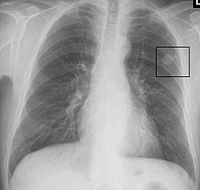
Photo from wikipedia
Background Patients who undergo lung resection are at risk of postoperative cerebral infarction, but the risk factors remain unclear, so the present study was a comprehensive investigation in patients who… Click to show full abstract
Background Patients who undergo lung resection are at risk of postoperative cerebral infarction, but the risk factors remain unclear, so the present study was a comprehensive investigation in patients who underwent lung resection for pulmonary nodules. Methods The clinical characteristics of patients with postoperative cerebral infarction and patients who underwent lung resection on the same day but did not develop cerebral infarction were retrospectively compared. Univariate and multivariate logistic regression analyses were performed to identify the independent risk factors for cerebral infarction after lung resection. Results A total of 22 patients with postoperative cerebral infarction and 316 controls were included. Multivariate logistic regression analysis revealed that a history of cerebral infarction [odds ratio (OR), 7.289; P=0.030], activated partial thromboplastin time (APTT) <26.5 s (OR, 3.704; P=0.018), body mass index (BMI) ≥24.0 kg/m2 (OR, 3.656; P=0.015), and surgical method (P=0.005) were independent risk factors for cerebral infarction after lung resection. Compared with patients undergoing lobectomy, the risk for postoperative cerebral infarction was significantly increased in patients undergoing segmentectomy (OR, 24.322; P=0.001), wedge resection (OR, 6.992; P=0.018), or combined surgical approach (OR, 29.921; P=0.028). Conclusions A history of cerebral infarction, APTT <26.5 s, BMI ≥24.0 kg/m2, and surgical method were independent risk factors for cerebral infarction after lung resection. Strengthening thromboprophylaxis in patients with these risk factors may help to reduce the incidence of postoperative cerebral infarction.
Journal Title: Journal of Thoracic Disease
Year Published: 2023
Link to full text (if available)
Share on Social Media: Sign Up to like & get
recommendations!